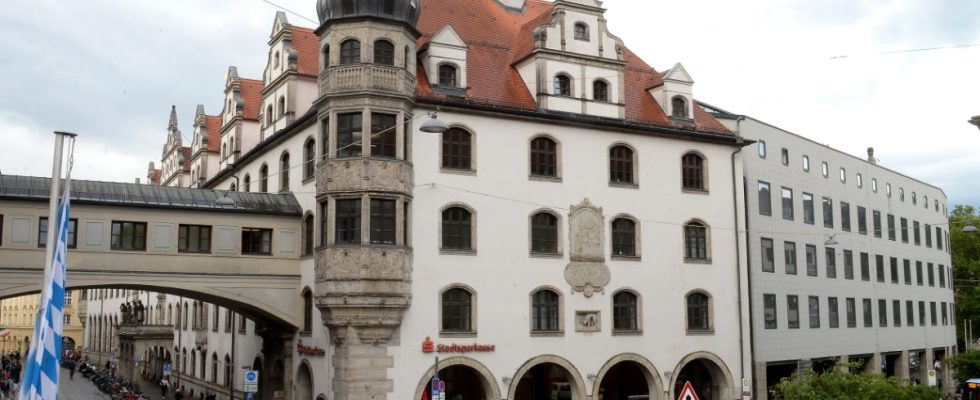In Munich, people were still paying with guilders when the “Savings Bank of the Royal Capital and Residence of Munich” set up its first branch. It was called “Einlagebuereau” at the time and was located at Angersbachstrasse 13. You won’t find it on any city map today because the stream that gave it its name has been moved underground over the years; At the Unterer Anger you can get very close to the location. The “Einlagebuereau” was opened on January 2nd, 1824, so the day after New Year’s Day is the 200th anniversary. And 2024 will mark the 125th anniversary of the bank’s move to its current location between Tal and Ledererstrasse. The Bräuhaus-Gässchen, which once connected these two streets, was renamed Sparkassenstrasse a few years later.
The “Savings Bank of the Royal Capital and Residence City of Munich” has changed its name several times over the years. It has been called Stadtsparkasse München since 1971, and it has a lot planned to celebrate its existence. The actions begin on New Year’s Eve at midnight with a “digital video fireworks display” by Munich artist Betty Mü. The bank promises that it will “spectacularly showcase” the southern facade of the Stadtsparkasse headquarters in the valley.
The video fireworks will be followed by a birthday film; the entire projection will last until 3 a.m. On January 1st and 2nd, the birthday film will be repeated in a continuous loop between 5 p.m. and 9 p.m. An adventure day for customers at Hellabrunn Zoo (on July 13th) is also planned for the course of the year. The bank announced that a lot more information about the 200th anniversary will be available on a subpage of the homepage www.sskm.de from December 27th.
Historical advertising for the Städtische Sparkasse.
(Photo: Stadtsparkasse)
The Stadtsparkasse München has a lot to offer historians, even if it was not the first of its kind in Germany. The savings bank system arose at the end of the 18th century out of the need of the so-called “little” people. Back then, they had no way of putting money aside for retirement or health care. The “Savings Bank” installed by the Hamburg General Supply Institution in 1778 is considered to be the oldest savings bank in the world. At the time, it issued savings accounts to sailors and day laborers so that they could invest their savings, even for interest.
In Bavaria, Nuremberg (1821), Schweinfurt, Regensburg, Bayreuth and Landshut (all 1823) had already set up municipal savings banks before the municipal authorities’ decision was implemented in Munich and a municipal savings bank with a charitable mission was also opened at the beginning of 1824. This meant that servants, craftsmen and workers in the Bavarian capital now had a chance to keep their hard-earned money in a safe place. She no longer had to hide it in a stocking under the pillow in her chambers or shared accommodation.

A photo of the old ticket hall from 1965.
(Photo: Stadtsparkasse)
However, the savings bank in the royal capital and residential city of Munich turned out to be not so safe at least once: in the revolutionary year of 1848 it was bankrupt. After panicked withdrawals, there was no more money in the cash register, it was insolvent, and the counters remained temporarily closed. It took a few years, but the city savings bank recovered. Last year, with total assets of more than 23 billion euros, it was the fourth largest savings bank in Germany, behind Hamburg, Cologne and Cologne-Bonn.
The number of branches, initially housed in drugstores and pharmacies, grew from twelve (1894) to 100 (1977) – and has since then shrunk again, to 46 today. There are almost 50 self-service locations: branches without staff where you can do your Financial transactions carried out at ATMs. The Stadtsparkasse has always been a pioneer when it comes to information technology and electronic data processing: at the end of the 1960s, it was one of the first financial institutions in Europe to network its branches using IT and IT.

A lottery poster from 1911.
(Photo: Stadtsparkasse)
In its history, the Münchner Sparkasse has survived numerous currency reforms, from guilders to thalers, through marks and pfennigs to euros and cents. And it has gone through various political orders, from the Kingdom of Bavaria in the German Confederation and the Empire through the Soviet Republic and the Weimar Republic to the National Socialist dictatorship and ultimately the Federal Republic. During the Nazi era it operated as the “Sparkasse of the Capital of the Movement Munich”; To come to terms with those years, the bank has agreed on a research project with the Nazi Documentation Center.
“Our mission is to enable people to participate economically and socially in society,” says CEO Ralf Fleischer, outlining his bank’s mission today. Of course, this not only looks after the well-being of the people in Munich, but also keeps the local economy running with capital and loans.
After the Second World War, it provided funding for reconstruction: in the 1950s, the Sparkasse financed around a quarter of all new buildings in the city, and during the building boom before the 1972 Olympics, it even rose to 40 percent. Just as the Sparkasse had supported public projects such as the sewer system in the 19th century, it contributed to the construction of the subway and the Mittlerer Ring in the 20th century. With now six foundations, the Stadtsparkasse München is also committed to social and community projects.

